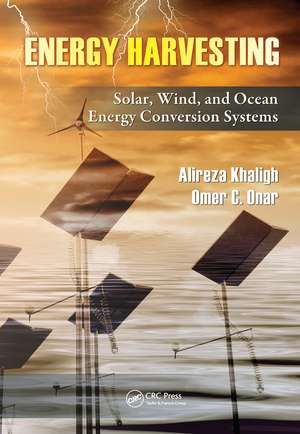Energy Harvesting: Solar, Wind, and Ocean Energy Conversion Systems: Energy, Power Electronics, and Machines
Autor Alireza Khaligh, Omer C. Onaren Limba Engleză Hardback – dec 2009
Recognizing this need, Energy Harvesting: Solar, Wind, and Ocean Energy Conversion Systems describes various energy harvesting technologies, different topologies, and many types of power electronic interfaces for stand-alone utilization or grid connection of energy harvesting applications. Along with providing all the necessary concepts and theoretical background, the authors develop simulation models throughout the text to build a practical understanding of system analysis and modeling.
With a focus on solar energy, the first chapter discusses the I−V characteristics of photovoltaic (PV) systems, PV models and equivalent circuits, sun tracking systems, maximum power point tracking systems, shading effects, and power electronic interfaces for grid-connected and stand-alone PV systems. It also presents sizing criteria for applications and modern solar energy applications, including residential, vehicular, naval, and space applications. The next chapter reviews different types of wind turbines and electrical machines as well as various power electronic interfaces. After explaining the energy generation technologies, optimal operation principles, and possible utilization techniques of ocean tidal energy harvesting, the book explores near- and offshore approaches for harvesting the kinetic and potential energy of ocean waves. It also describes the required absorber, turbine, and generator types, along with the power electronic interfaces for grid connection and commercialized ocean wave energy conversion applications. The final chapter deals with closed, open, and hybrid-cycle ocean thermal energy conversion systems.
Preț: 1288.34 lei
Preț vechi: 1571.15 lei
-18% Nou
Puncte Express: 1933
Preț estimativ în valută:
246.51€ • 257.41$ • 203.57£
246.51€ • 257.41$ • 203.57£
Carte tipărită la comandă
Livrare economică 16-30 aprilie
Preluare comenzi: 021 569.72.76
Specificații
ISBN-13: 9781439815083
ISBN-10: 1439815089
Pagini: 382
Ilustrații: 384 b/w images, 12 tables and 505
Dimensiuni: 178 x 254 x 23 mm
Greutate: 0.91 kg
Ediția:1
Editura: CRC Press
Colecția CRC Press
Seria Energy, Power Electronics, and Machines
ISBN-10: 1439815089
Pagini: 382
Ilustrații: 384 b/w images, 12 tables and 505
Dimensiuni: 178 x 254 x 23 mm
Greutate: 0.91 kg
Ediția:1
Editura: CRC Press
Colecția CRC Press
Seria Energy, Power Electronics, and Machines
Public țintă
Engineers, practitioners, researchers, and graduate and senior undergraduate students in energy harvesting, renewable/alternative energy sources, and power electronic interfaces.Cuprins
Solar Energy Harvesting. Wind Energy Harvesting. Tidal Energy Harvesting. Ocean Wave Energy Harvesting. Ocean Thermal Energy Harvesting. Index.
Notă biografică
Alireza Khaligh is the director of the Energy Harvesting and Renewable Energies Laboratory (EHREL) at the Electric Power and Power Electronics Center (EPPEC) in the electrical and computer engineering department at the Illinois Institute of Technology.
Omer C. Onar is a doctoral research assistant in the Energy Harvesting and Renewable Energies Laboratory (EHREL) at the Electric Power and Power Electronics Center (EPPEC) in the electrical and computer engineering department at the Illinois Institute of Technology.
Omer C. Onar is a doctoral research assistant in the Energy Harvesting and Renewable Energies Laboratory (EHREL) at the Electric Power and Power Electronics Center (EPPEC) in the electrical and computer engineering department at the Illinois Institute of Technology.
Descriere
This work describes various energy harvesting technologies, different topologies, and many types of power electronic interfaces for stand-alone utilization or grid connection of energy harvesting applications. Along with providing all the necessary concepts and theoretical background, the authors develop simulation models throughout the text to build a practical understanding of system analysis and modeling. They cover the technical aspects of renewable energy systems and assess the environmental impact of generating energy from the ocean. They also explore the design of applications, such as a solar-powered satellite energy system and several wave energy generators and converters.














